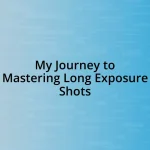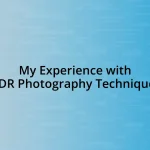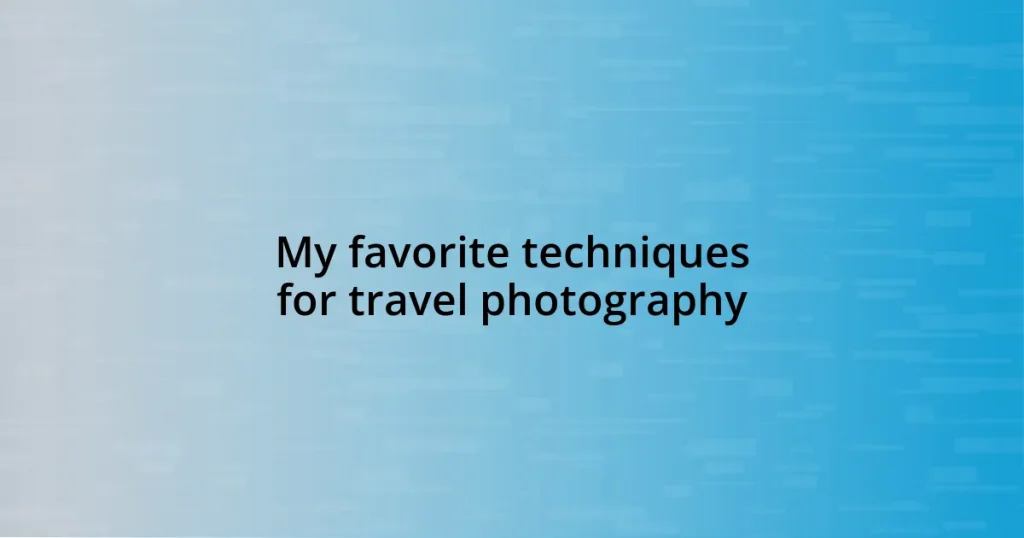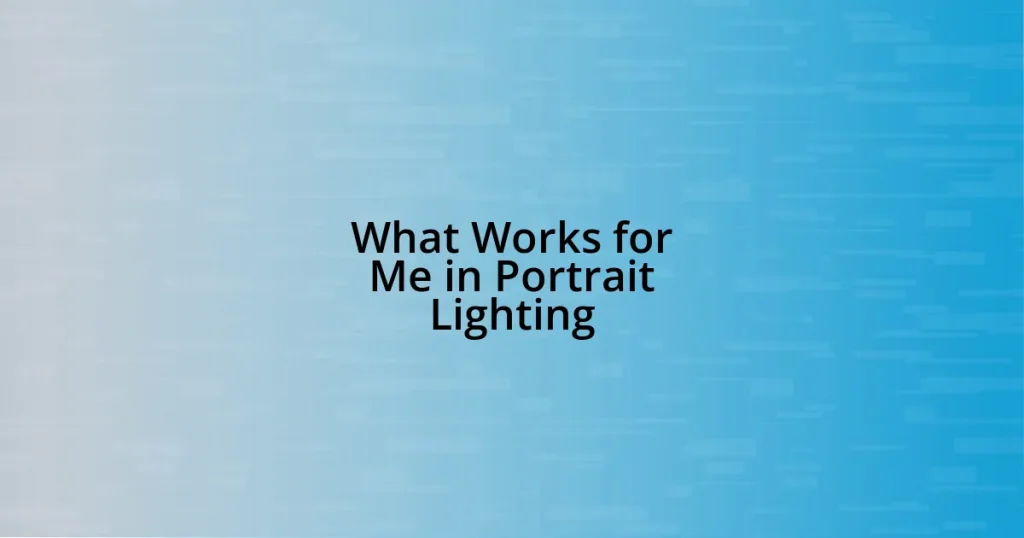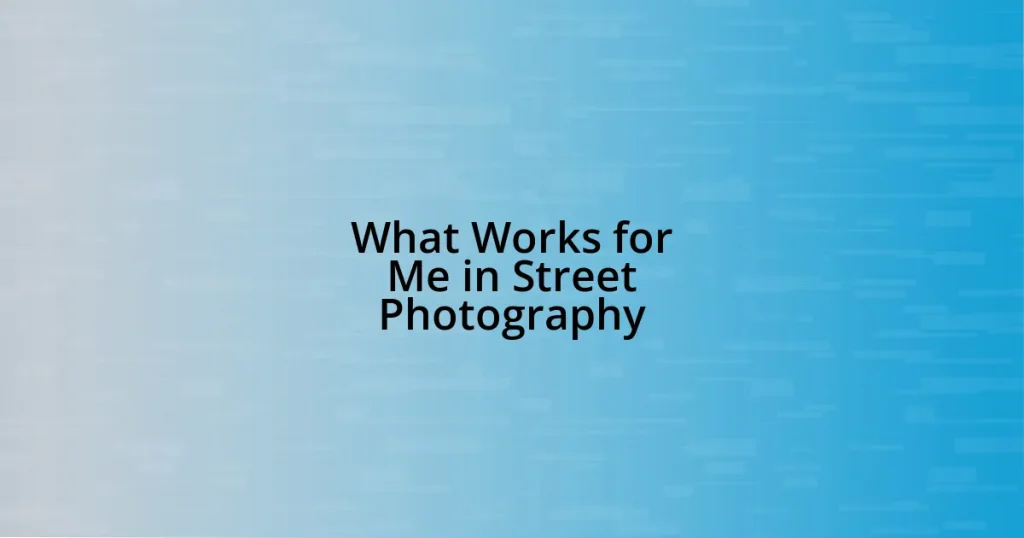Key takeaways:
- Travel photography essentials include a lightweight camera, versatile lenses, and useful accessories like tripods and extra batteries.
- Effective techniques for capturing landscapes involve using leading lines, natural frames, and taking advantage of golden hour lighting.
- For candid portraits, patience, a longer focal length, and a focus on the eyes help capture genuine moments and emotions.
- Post-processing enhances travel photos through adjustments in contrast, shadows, and selective editing to highlight focal points.
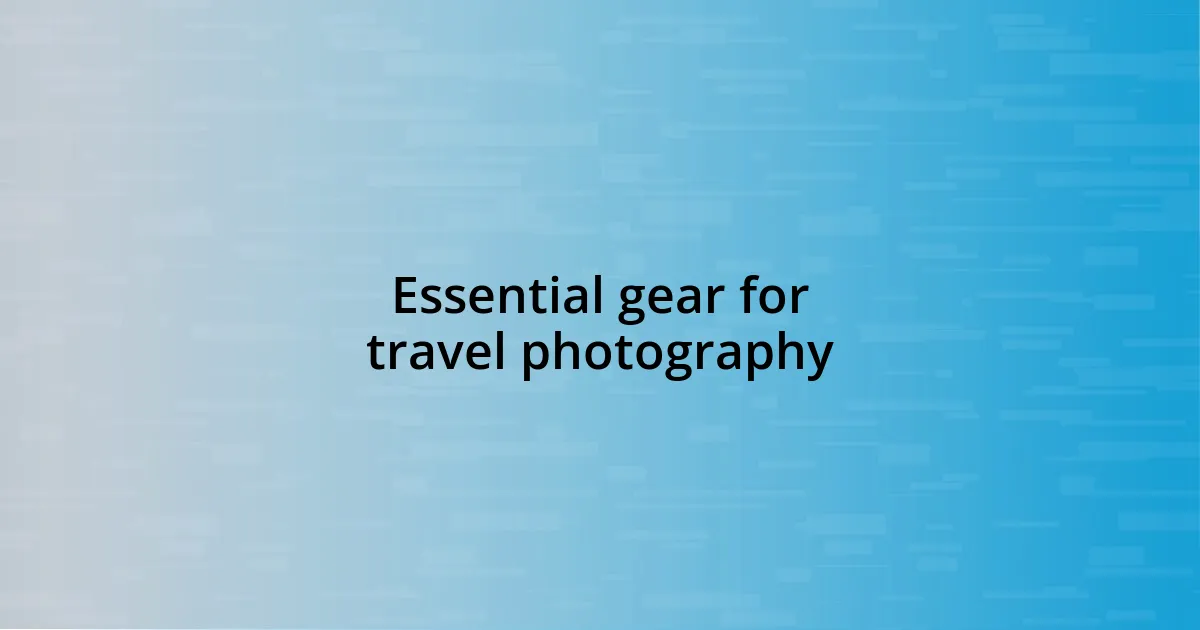
Essential gear for travel photography
When I think about essential gear for travel photography, my mind immediately goes to the camera. I remember my first trip to Europe, where I lugged around a heavy DSLR. It was a fantastic camera, no doubt, but I soon learned that a lighter mirrorless option not only made long days of exploring easier but ensured I captured all those spontaneous moments without feeling weighed down.
Lenses are just as crucial as the camera itself. I often carry a versatile zoom lens along with a prime lens. There’s something magical about a prime lens that allows for beautiful, crisp images in low light—especially when you’re wandering through dimly lit alleyways during golden hour. Have you ever felt the thrill of capturing the perfect shot when the light hits just right? It’s indescribable.
Don’t overlook accessories; they can make or break a trip. I always pack a portable tripod for those stunning landscape shots, and a few extra batteries are a must; nothing is more disheartening than missing a beautiful sunset due to a dead battery. Trust me, learning these lessons the hard way can create some unforgettable memories… but of a different kind!
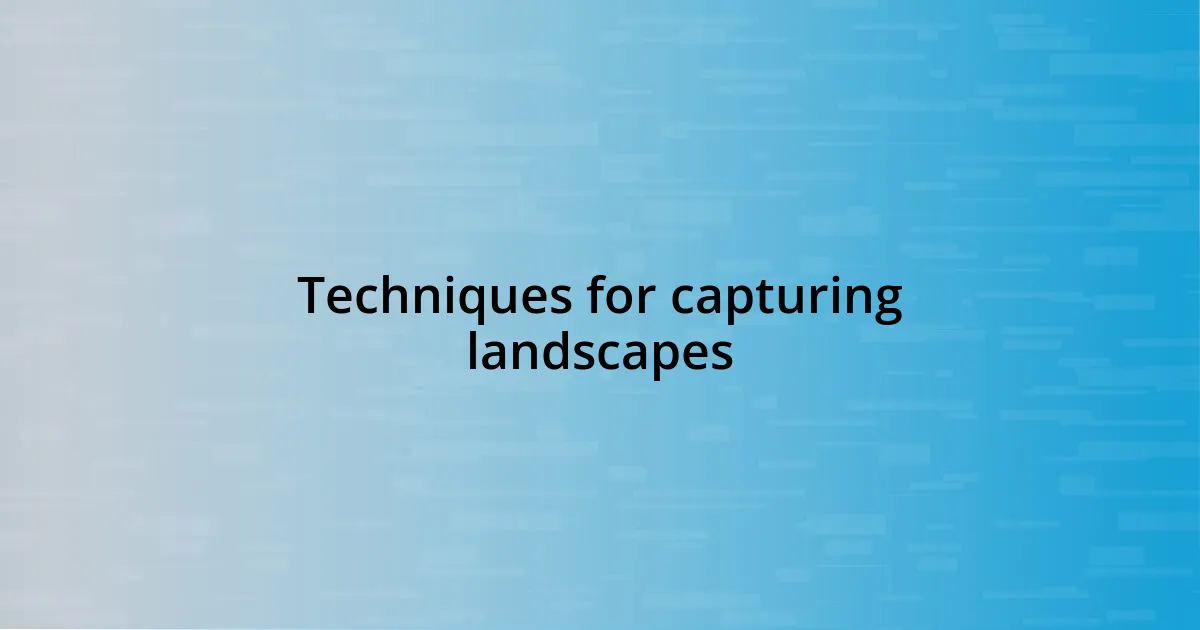
Techniques for capturing landscapes
Capturing landscapes is one of the most fulfilling aspects of travel photography. I often find myself mesmerized when standing before a breathtaking vista, whether it’s a rugged mountain range or a serene beach at sunrise. One technique that has changed my approach is using leading lines. These can be anything from winding roads to a meandering river, guiding the viewer’s eye into the frame. Have you ever noticed how a simple line can create a sense of depth? It’s like the landscape is inviting you in for a closer look.
Another technique that’s proven invaluable is the use of natural frames. I often seek out branches or rock formations to frame my subjects. This adds an extra layer of interest and draws attention to the focal point of your image. It helps transport me back to that moment, like peering through a window into a magical world. Remember the last time you saw a photo that pulled you in? That’s the kind of feeling I aim for in my landscape shots.
Don’t underestimate the golden hour, that magical time just after sunrise and before sunset. The soft, warm light can transform a mundane scene into something extraordinary. I still recall a moment standing on a cliff’s edge as the sun dipped below the horizon, painting the sky in hues of orange and pink. It was a perfect reminder that timing is everything in landscape photography, and it often leaves a lasting impression.
| Technique | Description |
|---|---|
| Leading Lines | Using elements in the scene that guide the viewer’s eye into the photograph, creating depth. |
| Natural Frames | Utilizing elements like branches or rocks to encase the subject, adding interest and focus. |
| Golden Hour | Capturing images during the soft light of sunrise or sunset for warm, inviting tones. |

Tips for taking candid portraits
Taking candid portraits can feel like both an art and a race against time. There’s something exhilarating about capturing a spontaneous moment; it’s like freezing time in a single, perfect frame. I remember wandering through a bustling market in Marrakech, camera in hand, and snagging a shot of an elderly man laughing with his friends. His joy radiated, and in that moment, I understood that candid photography is about being present, observing what’s unfolding around you, and being ready to click when the magic happens.
Here are some practical tips that have helped me greatly:
- Be patient and wait for moments to unfold: Instead of forcing interaction, I often let scenes develop naturally. This can lead to capturing genuine emotions.
- Use a longer focal length: When I opt for a zoom lens, it allows me to shoot from a distance without intruding on the subject’s experience. This helps preserve authenticity.
- Focus على the eyes: The eyes often convey the subject’s feelings, so I always direct my focus there—it’s the emotional connection that makes a portrait compelling.
- Engage with the environment: Setting context helps. Capturing a subject within their surroundings tells a story, adding depth to the portrait.
- Don’t worry about perfection: Some of my favorite portraits have slight blurs or unexpected elements. Those are the quirks that make the shot unique and memorable.
Every time I capture a candid moment, I’m reminded of why I love photography—it’s about stories, emotions, and the beauty of life unfolding right in front of us.
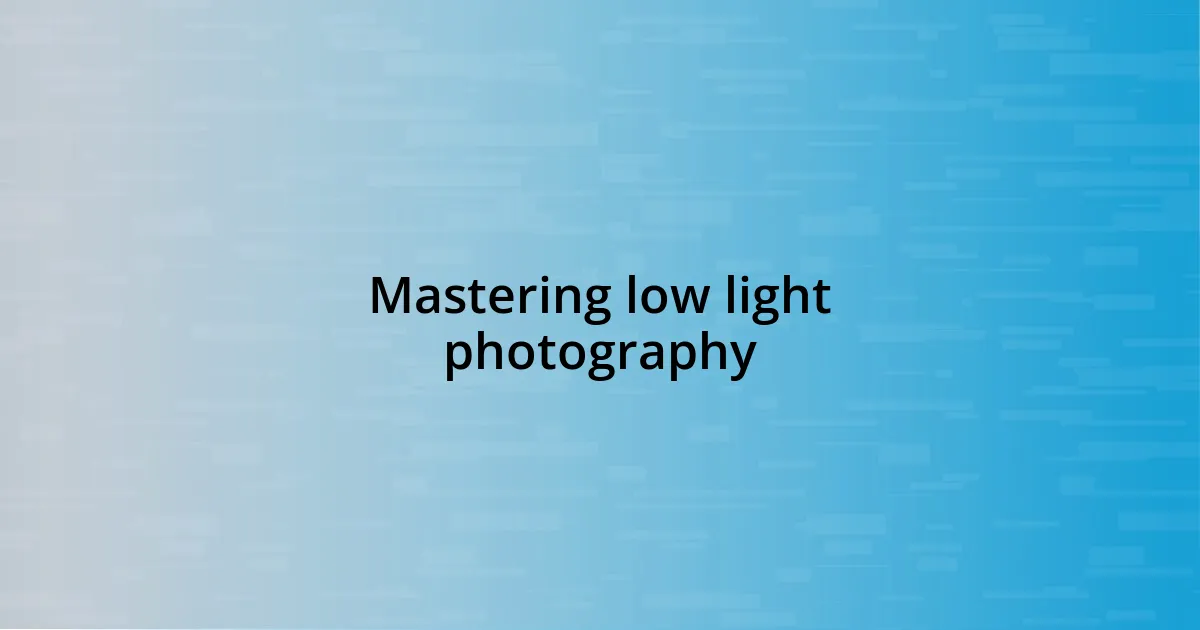
Mastering low light photography
Mastering low light photography not only challenges your technical skills but also opens up a world of creative possibilities. One memorable evening, I found myself in an ancient, dimly lit temple, where the light danced dramatically on the stone walls. That’s when I realized the importance of using a wide aperture, like f/1.8 or f/2.8. This setting allows more light to hit the sensor, creating beautifully blurred backgrounds that draw attention to your subject. Have you ever noticed how such subtle adjustments can transform an ordinary scene into something almost ethereal?
Tripods become my best friend in low light situations; they provide stability that keeps the image sharp, especially during longer exposures. I’ll never forget the time I captured a bustling night market in Thailand, lights twinkling like stars through the haze. Setting my shutter speed to 5 seconds allowed the movement of the crowd to blur, giving the photo a sense of life and energy. If you haven’t tried experimenting with slower shutter speeds, I highly recommend you do. The results can be surprisingly dynamic!
Lastly, I’ve learned to embrace the power of post-processing. Sometimes, the right adjustments can breathe life into your low-light shots. Just the other day, I revisited an old photo taken at dusk—originally too dark—only to enhance its vibrancy through editing. The right balance of exposure and contrast transformed the image, making it reminiscent of the memory it captured. Don’t be afraid to explore these tools; after all, it’s about making sure your photographs reflect the feelings and experiences that inspired them.

Utilizing natural light effectively
Light plays a crucial role in photography, and mastering its nuances, especially natural light, has drastically enhanced my travel photography. I still vividly recall standing on a beach in Bali during the “golden hour,” just as the sun dipped below the horizon. The warm, soft light bathed everything around me, transforming the scene into a painter’s palette. Have you ever experienced that magical moment when the world seems to glow? I find that shooting during this time not only creates stunning images but also resonates deeply with the emotion of the moment.
One of my favorite techniques for utilizing natural light effectively is to use shadows to my advantage. I remember walking through a narrow alleyway in Santorini, where shadows danced playfully against the whitewashed buildings. By angling my camera strategically, I was able to capture the interplay between light and dark, which added depth to my photos. This stark contrast not only highlights textures but also draws the viewer’s eye into the image. It’s fascinating how such simple elements can evoke a strong emotional response, don’t you think?
Controlling your posture and angle is another effective way to harness natural light. I often experiment with positioning myself so that the light hits my subject in just the right way. During a sunrise hike in the Andes, I discovered that moving just a few steps changed the mood of my shots entirely. The sun illuminating the peaks created a sense of majesty, while the mist below added an otherworldly quality. By being aware of how light interacts with your surroundings, you can create images that speak volumes about your experiences, raising the question: what story do you want your photograph to tell?

Composing striking travel shots
When it comes to composing striking travel shots, the rule of thirds has become my go-to guideline. I remember standing atop a hill in Cinque Terre, where vibrant houses clung to the cliffs, cascading down to the sea. By positioning the horizon line along the upper third of my frame and placing the colorful buildings on one side, the photo became a visual journey that drew the viewer’s eye. Have you ever noticed how framing your subject off-center can create a more dynamic composition?
Another technique I love is leading lines. I stumbled upon this when I captured a photo in an ancient Italian vineyard, where rows of grape vines intertwined like pathways beckoning to adventure. By aligning the vines to draw the viewer’s gaze toward the distant hills, I created a sense of depth and movement in the image. It’s remarkable how something as simple as perspective can transform a shot from ordinary to extraordinary. Have you tried using elements in your environment as guides for the eye?
Lastly, don’t underestimate the impact of negative space. During a serene moment on a remote beach in New Zealand, I decided to frame my subject with plenty of open sky and sand around them. This minimalist approach not only highlighted the beauty of my friend gazing at the horizon but also evoked a profound sense of solitude. It invites the viewer to pause and reflect, making them feel as if they are stepping into the scene themselves. Isn’t it fascinating how composition can convey emotions and tell stories all at once?

Post processing for travel photos
Post-processing is where I truly bring my travel photos to life. After capturing a breathtaking sunset in the Maldives, I dove into editing, using software to enhance the colors and highlights effortlessly. It’s amazing how adjusting the vibrancy can translate that idyllic scene into a visual feast. Have you ever noticed how a bit of post-production magic can completely change the mood of your image?
One of my top techniques is the use of contrast and shadows to create depth. Just last year, while reviewing photos from a street market in Marrakech, I took the time to amplify the contrasts. The rich hues and intricate patterns of the textiles jumped right off the screen! It made me wonder, how often do we overlook what a little fine-tuning in editing can do to spotlight the beautiful details we initially captured?
I also find that localizing my edits to specific areas of a photo can dramatically affect its impact. For instance, after snapping a photo of the iconic Eiffel Tower at twilight, I highlighted the tower itself while keeping the surrounding area slightly muted. This technique directed eyes straight to the landmark—the heart of my photo story. Have you tried using selective editing to breathe life into your images? It’s a game-changer in making the focal point resonate with your audience.






